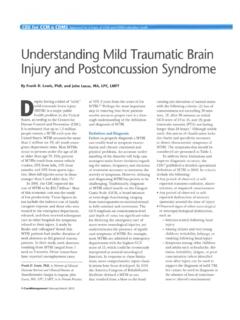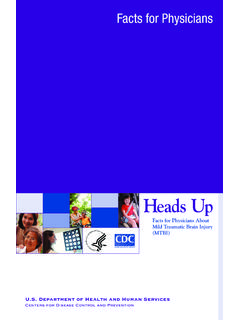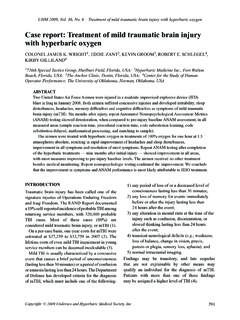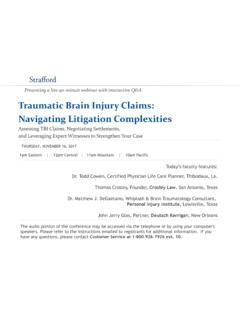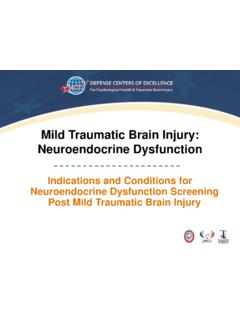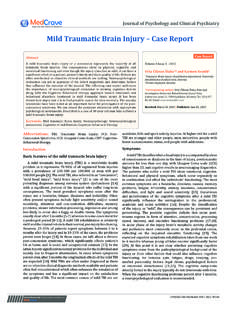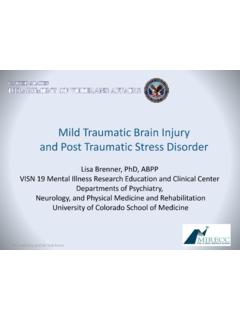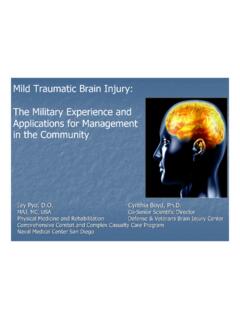Transcription of Brain Injury and Symptoms - ONF
1 Guidelines for mild traumatic Brain Injury and Persistent Symptoms The Guidelines Development Team would like to acknowledge the Ontario Neurotrauma Foundation, who initiated and funded the development of the guidelines. With funding support from the Ministry of Health and Long Term Care, ONF works with consumers, researchers, practitioners, policy and decision makers to create not only a research agenda but a knowledge mobilization agenda to create the necessary changes to reduce and/or eliminate neurotrauma injuries (acquired Brain or spinal cord injuries) and to improve the quality of life for those Ontarians living with these devastating injuries. Please note, the Guidelines Development Team independently managed the development and production of the guideline and, thus, editorial independence is retained. TABLE OF CONTENTS. INTRODUCTION 1. METHODOLOGY 5. REFERENCES 9. GUIDELINES. 1. Diagnosis/Assessment of mTBI 11. 2 Management of mTBI 14.
2 3. Sport-Related mTBI 17. 4. General Recommendations Regarding Diagnosis/Assessment of Persistent Symptoms Following mTBI 20. 5. General Recommendations Regarding Management of Persistent Symptoms Following mTBI 21. 6. Post- traumatic Headache 22. 7. Persistent Sleep Disturbances 25. 8. Persistent Mental Health Disorders 27. 9. Persistent Cognitive Difficulties 32. 10. Persistent Balance Disorders 35. 11. Persistent Vision Disorders 37. 12. Persistent Fatigue 37. 13. Return to Work/School Considerations 39. APPENDICES. Appendix A: Project Members 41. Appendix B: Formal Schema Used in the Establishment of the mTBI Expert Consensus Group 42. Appendix C: Conflicts of Interest 43. Guideline 1. Appendix : Abbreviated Westmead Post traumatic Amnesia Scale 44. Appendix : Brain Injury Advice Card 47. Appendix : Rivermead Post Concussion Symptoms Questionnaire 53. Guideline 2. Appendix : Specialized Brain Injury Clinics/Centres in Ontario 54.
3 Guideline 3. Appendix : Sport Concussion Assessment Tool 57. Appendix : Pocket-Sport Concussion Assessment Tool 61. Appendix : Safe Steps to Return to Play after a Possible traumatic Brain Injury Algorithm 63. Guideline 4. Appendix : ICD-10 Definitions for Differential Diagnoses Related to mTBI 64. Guideline 6. Appendix : ICHD-II Acute Post- traumatic Headache Attributed to mild Head Injury 67. Appendix : ICHD-II Chronic Post- traumatic Headache Attributed to mild Head Injury 68. Appendix : ICHD-II Diagnostic Criteria for Selected Primary Headache Types 69. Appendix : ICHD-II Medication-Overuse Headache 70. Appendix : Important Components to Include in the Neurological and Musculoskeletal Exam 71. Appendix : Advice on the Assessment and Management of Post- traumatic Headache 72. Appendix : ICSI Migraine Treatment Algorithm 74. Appendix : ICSI Migraine Prophylactic Treatment Algorithm 75. Appendix : ICSI Tension-Type Headache Algorithm 76.
4 Appendix : Information on Diagnosis and Management of Occipital Neuralgia Headache 77. Guideline 7. Appendix : Sleep Hygiene Guide for Patients and Sleep Diary 78. Appendix : Therapeutic Options 79. Appendix : Advice on Sleep Consolidation 81. Guideline 8. Appendix : Initial Screening and Assessment Recommendations 82. Appendix : Patient Health Questionnaire 85. Appendix : PTSD Checklist-Civilian Version 87. Guideline 10. Appendix : Dix-Hallpike Manoeuvre and Particle Repositioning Manoeuvre 88. Guideline 12. Appendix : Fatigue Severity Scale 89. Appendix : List of Medications Associated with Fatigue, Asthenia, Somnolence and Lethargy 90. Appendix : Patient Advice Sheet on Coping Strategies for Fatigue 92. Guideline 13. Appendix : Return to Work/Study Considerations 94. Appendix D: Sources for the mTBI Guideline Recommendations 96. Appendix E: Results of the mTBI Systematic Review of the Literature 134. Appendix F: Search Results for Existing TBI Guidelines 149.
5 LIST OF TABLES. 1 Common Symptoms of mTBI 2. 2 Diagnostic Criteria for mild traumatic Brain Injury by the ACRM 2. 3a Diagnostic Criteria for Post-Concussion Syndrome (ICD-10) 3. 3b Diagnostic Criteria for Post Concussional Disorder (DSM-IV) 3. 4 Symptom Treatment Hierarchy 4. 5 Existing TBI Guidelines Evaluated in the Process of Developing the Current Guideline 6. 6 Levels of Evidence 8. 7 Medical Factors and Contextual Factors Influencing Recovery Post mTBI 11. 8 Signs of Possible Sport-Related mTBI 17. 9 Differential Diagnoses Related to mTBI 20. 10 General Considerations Regarding Pharmacotherapy After mTBI 30. 11 Factors Associated with Poor Functional Outcomes 39. LIST OF FIGURES. 1 Practice Guidelines Evaluation and Adaptation Cycle 5. 2 AGREE Ratings for Rigour of Development Domain 7. 3 Canadian CT Head Rule 13. 4 Clinical Assessment of Balance 35. INTRODUCTION. Overview The Ontario Neurotrauma Foundation (ONF) initiated this project with the overall objective to create a set of guidelines that can be used by healthcare professionals to implement evidence-based, best practice care of individuals who incur a mild traumatic Brain Injury (mTBI) and experience persistent Symptoms .
6 Persistent Symptoms are not an uncommon complication of mTBI; 10 to 15% of individuals who incur mTBI will continue to experience significant Symptoms beyond the normal recovery period of three months (Iverson, 2005), which can include post- traumatic headache, sleep disturbance, disorders of balance, cognitive impairments, fatigue, and mood or affective disorders. With the high incidence of mTBI this potentially translates to a significant number of individuals who may experience associated disability. Currently, the best practice for treatment of those who do not experience spontaneous recovery is not clearly defined. Therefore, the following clinical questions needed to be addressed -- Can an approach be devised to screen for and identify patients that are at high-risk of persistent Symptoms and, once identified, can a management plan be developed to treat the Symptoms commonly associated with the disorder? Hence the purpose of developing the clinical guidelines is to improve patient care by creating a framework that can be implemented by health professionals to effectively identify and treat individuals who manifest persistent Symptoms following mTBI.
7 Scope The present guidelines are appropriate for use with adults ( 18 years) who have experienced mTBI. The present guideline is not appropriate for use with patients who have incurred penetrating Brain injuries, birth injuries, Brain damage from stroke or other cerebrovascular accidents, shaken baby syndrome, or moderate to severe closed head injuries. The guideline addresses early management to only a limited extent because the purpose of this document is to provide guidance on the assessment and treatment of persistent Symptoms . Nonetheless, because early management can influence the development and maintenance of persistent Symptoms , the most critical issues regarding early management have been incorporated. For more comprehensive guidance on pre- hospital and acute care, readers are directed to the Motor Accidents Authority of NSW Guidelines for mild traumatic Brain Injury following a Closed Head Injury ' (MAA NSW, 2008, ).
8 The present document targets healthcare professionals providing service to individuals who have experienced mTBI, including health care providers, neurologists, physiatrists, psychiatrists, psychologists, counselors, physiotherapists, occupational therapists, and nurses. Background Information on mTBI and Persistent Symptoms Over the years various terms have been used synonymously with mild TBI, such as mild head Injury and concussion. In this document the term mild TBI is used, and denotes the acute neurophysiological effects of blunt impact or other mechanical energy applied to the head, such as from sudden acceleration, deceleration or rotational forces (Bigler, 2008; MAA NSW, 2008). mTBI is among the most common neurological conditions with an estimated annual incidence of 200/100,000 in the United States (Kraus et al., 1996). A recent Canadian study examining both hospital-treated cases as well as those presenting to a family physician calculated the incidence of mTBI in Ontario to lie between 493/100,000 and 653/100, 000, depending on whether diagnosis was made by primary care physicians or a secondary reviewer (Ryu, Feinstein, Colantonio, Streiner & Dawson, 2009).
9 Guidelines for mTBI and Persistent Symptoms 1. The acute Symptoms that may follow mTBI are often categorized Table 1. Common Symptoms of mTBI. according to the following domains: 1) physical, 2) behavioural/. emotional, and 3) cognitive. Some of the more common Physical representatives of each symptom category are presented in Table Headache Nausea 1. Computed Axial Tomography (CAT) and conventional Magnetic Vomiting Resonance Imaging (MRI) usually fail to detect evidence of Blurred or double vision structural Brain abnormalities in mTBI. However, reviews of recent Seeing stars or lights advances in the biomechanical modeling of mTBI in humans and Balance problems animals conclude that mTBI leads to functional neuronal disruption, Dizziness and at times structural damage (Bigler, 2008; Giza & Hovda, 2001; Sensitivity to light or noise Son et al., 2000). Tinnitus Behavioural/Emotional There are several criteria commonly used to index severity of Drowsiness traumatic Brain injuries.
10 One is the Glasgow Coma Scale (GCS; Fatigue/lethargy Teasdale & Jennett, 1974), which assesses a patient's level of Irritability consciousness. GCS scores can range from 3 to 15;. mild TBI is Depression defined as a GCS score of 13-15, typically measured at 30 Anxiety Sleeping more than usual minutes post- Injury or on admission'. Post traumatic amnesia Difficulty falling asleep (PTA), measured as the time from when the trauma occurred until Cognitive the patient regains continuous memory, is another criteria used to Feeling slowed down . define Injury severity and the cut-off for mild injuries is usually Feeling in a fog or dazed . placed at 24 hours or less. Finally, a loss of consciousness of less Difficulty concentrating than 30 minutes has also served as an index of mild TBI (von Difficulty remembering Holst & Cassidy, 2004). However, it should be noted that mTBI 1. Adapted from Willer & Leddy, 2006. can occur in the absence of any loss of consciousness.
